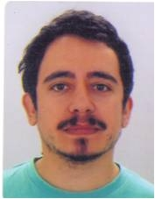Self-assembled monolayers on metal oxides: applications in nanotechnology
Promotion date: 8. December 2010
Promotors: Prof. dr. ir. Jurriaan Huskens
Prof. dr. ing. A.J.H.M. Rijnders
| The results in this thesis show the versatility and efficiency of phosph(on)ate-based self-assembled monolayers (SAMs) to modify and pattern metal oxides. The use for electrical applications and the adsorption of magnetic nanoparticles for data storage applications have been studied. By combining patterning techniques and self-assembly, functional inorganic-organic composite structures have been created. Combining patterning techniques with chemical modification achieved by self assembled monolayers - for controlled assembly and patterning magnetic nanoparticles on metal oxides - can be used to prepare spintronic devices. |
What were special aspects in your thesis project?
Working for two groups – Inorganic Materials Science and Molecular Nanofabrication – I studied quite a broad subject and combined different parts. Self-assembled monolayers together with metal oxides and fabrication techniques, is quite a special approach leading to functional inorganic-organic composite structures.
Controlled assembly of FePt magnetic nanoparticles was achieved by using SAMs. FePt nanoparticles are future candidates for magnetic data storage applications. Apart from magnetic properties, also the use for building new kinds of electronic circuits seems promising, as the metallic contacts can be prepared on SAM-functionalized metal oxides, without damaging the SAM-layer.
Did your work lead to nice publications?
One article already appeared in the International Journal of Molecular Sciences. Three more papers are in preparation to be submitted to high impact journals like Advanced Functional Materials.
In what way did you develop as a researcher and scientist?
First of all, I increased my knowledge a lot. Also, I very much liked the multidisciplinary approach, working closely together with two research groups. Being a chemical engineer originally, I was not surprised finding the world of physics, materials science, chemistry and nanotechnology on one subject.
Secondly, I developed a lot of important experimental skills, for example atomic force microscopy, nanoimprint lithography, pulsed laser deposition and cleanroom experience.
In my opinion, working in nanotechnology involves a big amount of experimental skills, as one is always dealing with a high-tech environment.
What are your future plans?
Right now, I am working at TMC Physics. My working laboratory is situated at Philips High Tech Campus, Philips Research. The investigations I am involved in are part of the developing stages of future applications. It resembles the scientific approach and routines very much so. This fits my ambition well, to still learn more techniques and skills, and to personally grow as an engineer and nano research expert.
What, in your opinion, is important for Mesa+ to stay at a high international level of quality?
It has a multicultural and open atmosphere which I think is quite important. The groups within Mesa+ are very strong and possess interesting specialized topics, which are well defined.
In my opinion more structural ways of communication and collaboration between these research groups and among colleagues, can create more opportunities to promising future subjects, as the know-how and technical abilities and facilities at Mesa+ are very good indeed.

